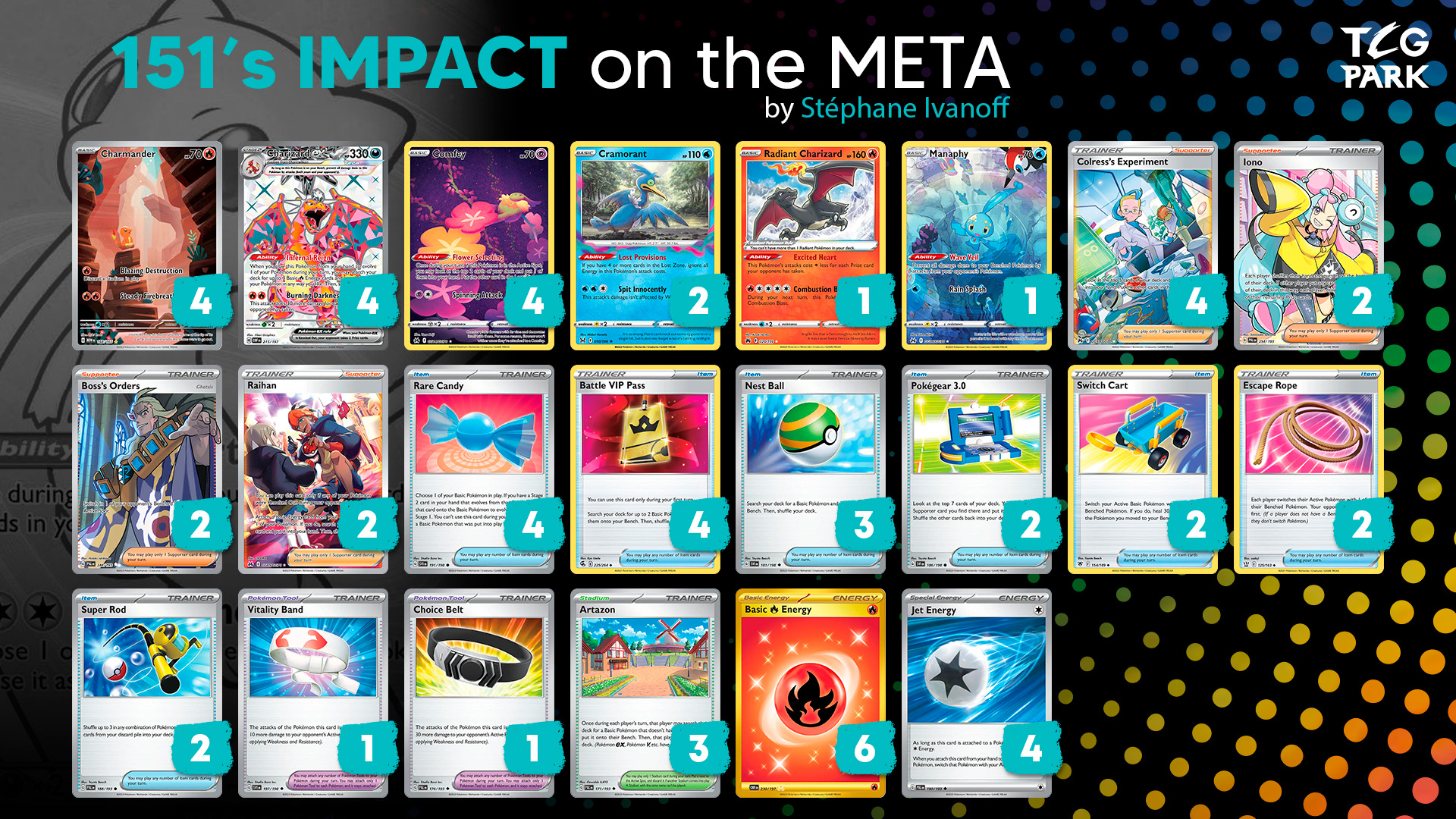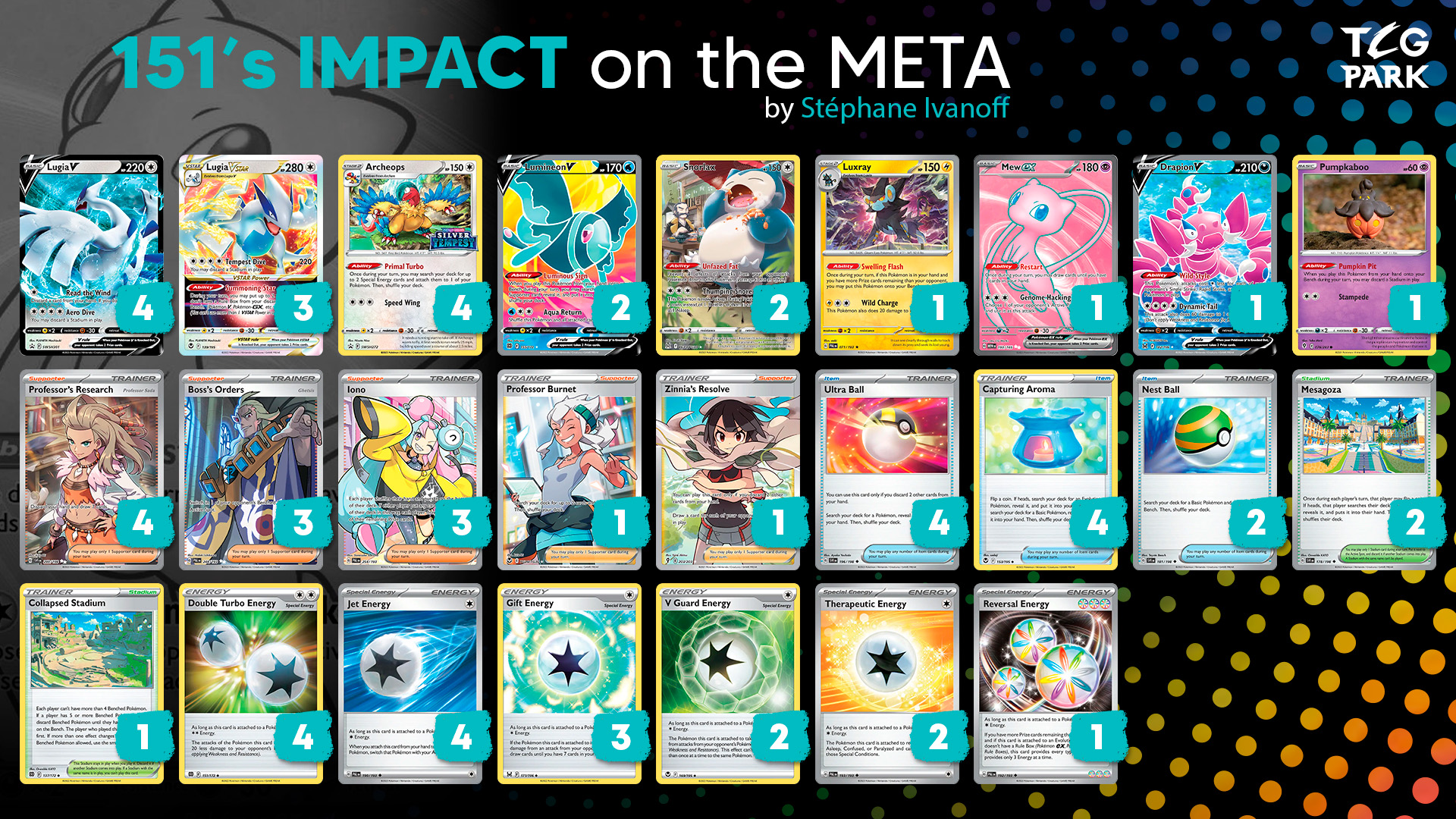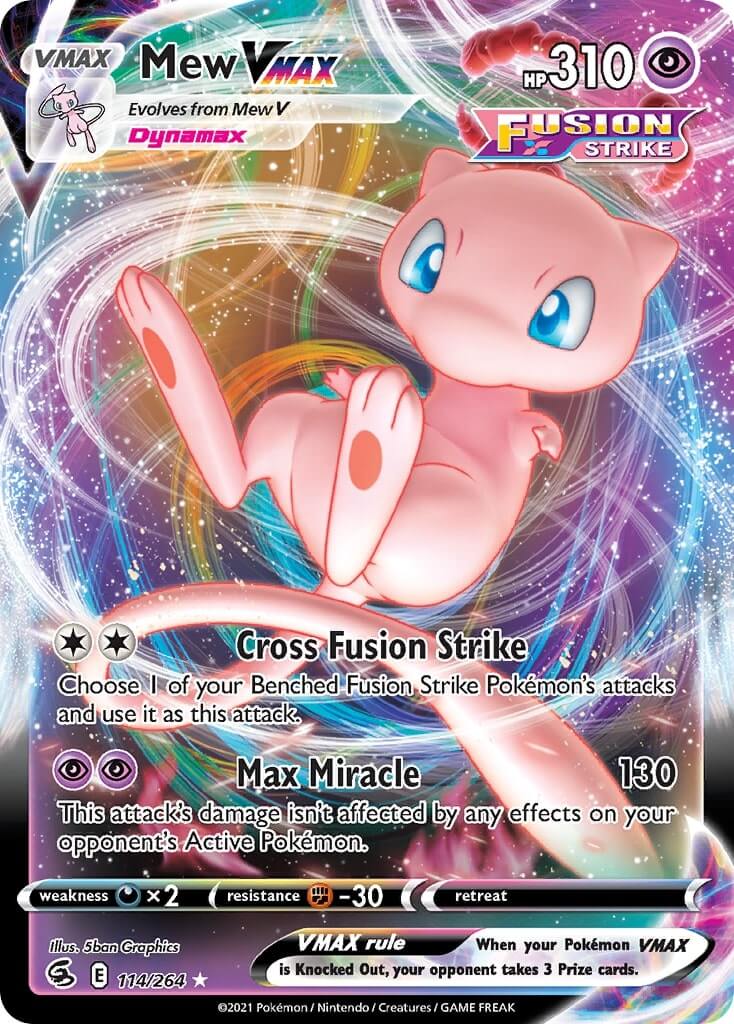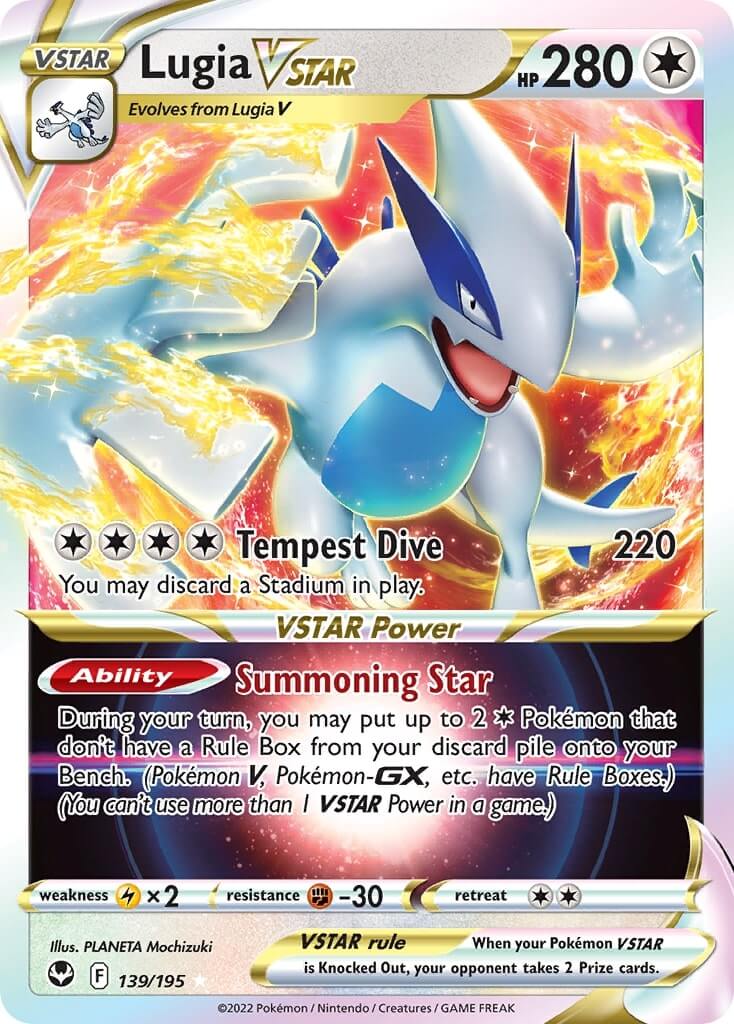Welcome back! I mentioned recently that the Obsidian Flames format had many different viable decks: Gardevoir ex, Giratina VSTAR, Lost Box, Miraidon ex, Lugia VSTAR, Mew VMAX, and more (Charizard ex being the newcomer to that group) all have had their time to shine.
That metagame will soon have to be updated, though, as the new mini-set 151 just released and will soon be legal in tournaments. As a small set, 151 will likely not have a disproportionate influence on the metagame, but even mini-sets can bring cards with a huge impact on the game: Pokémon Go had Radiant Charizard and PokéStop, Celebrations had Mew, Kyogre and Zacian V (and more!), and so on. Looking at early results from Japan, it looks like some of these new cards will shift the metagame a bit, and my goal today is to discuss how.
151 doesn’t seem to be the kind of set to spawn new archetypes. Some players will surely build around Blastoise ex or Wigglytuff ex, but to be honest, I don’t think these decks will be particularly strong. On the other hand, 151 seems to have a new card for plenty of already existing decks. For example, Hitmonlee seems to be made to be included in a Ting-lu ex deck, since it can, on turn 1, damage all the opponent’s Pokémon and bring Ting-lu ex in the Active spot, so that damaged Pokémon (Comfey, Kirlia, Baxcalibur, etc.) can’t use their Abilities. Will that be enough to make Ting-lu a relevant part of the metagame? Probably not, but at least it gives deckbuilders something new to try!
Similarly, Zapdos ex can fit in Miraidon ex decks (and in fact, was played alongside Hawlucha in the deck that won the Yokohama Champions League two weeks ago), Erika’s Invitation is a strong addition to Control decks, and Ditto is an interesting addition to fast Lost Box decks as it gives them essentially a fifth Comfey to start the game with. I’m not sure these cards will all see widespread play, but I like that they give me the opportunity to play a bit differently without having to learn a completely new metagame.
That said, even though 151 mostly encourages players to tweak existing decks rather than building new ones, that doesn’t mean that these new cards won’t have a noticeable impact. In the following, I’ll talk about three consequences of the 151 set, and include some decklists for you to try.
Charizard Ex gets better
One of the most important cards in the 151 set is, oddly enough, the small and innocuous Charmander. Not because of its attacks, although being able to discard Path to the Peak for one Energy is a nice bonus if you’re in a bad situation, but because it has 70 HP. One big weakness of Charizard ex decks has been their reliance on low HP Basics: Charmander, Pidgey and Mew all have 60 HP, making them very weak to a double KO from Sableye’s Lost Mine. The difference between 60 and 70 HP is also particularly noticeable in the Rapid Strike Urshifu VMAX / Inteleon VMAX, since it can much more easily deal with 60 HP Basics with Double Gunner, Painful Spoons and Yoga Loop. Urshifu / Inteleon has remained unpopular even after winning NAIC, so I don’t think it will suddenly be played in spades, but its triumph at the Barcelona SPE indicates that the deck is still relevant, so it’s always good to be prepared for it.
The question remains: which Charizard version is the best? I’m not sure of it myself, but I think that the popular way to build around Charizard ex, with Pidgeot ex and Arceus VSTAR, is not optimal. These Pokémon are all weak to Path to the Peak, and I don’t think it makes sense to pair Charizard ex with two-Prize Pokémon that can be KO’d more easily. After the Yokohama Champions League, I started testing Charizard ex / Gallade, which made top 8 at that event, and was pleasantly surprised by it. The deck could be slow to set up, but since the only two-Prize Pokémon it plays is Charizard ex, which has 330 HP, it can achieve impressive comebacks against faster decks.
However, in Barcelona, the highest-placing Charizard ex deck was Alberto Benvenga’s, who used the Lost Zone engine. Thanks to Comfey and Colress’s Experiment, this deck can use Cramorant as an early game attacker to put pressure on the opponent, then transition into Charizard ex. Colress’s Experiment is also one of the best Supporters we have to find a combination of two cards, hence why it was played last season in Arceus VSTAR / Duraludon VMAX (a deck that often wanted to find Hyper Potion and Double Colorless Energy on the same turn) : it digs digger than a simple draw Supporter like Nemona, but doesn’t require you to get rid of your existing cards like Professor’s Research or Iono. In Charizard, the two-card combination you need is Rare Candy and Charizard ex. Colress’s Experiment is even played in the Pidgeot ex / Arceus VSTAR variant of Charizard for this purpose.
That being said, I don’t think Mirage Gate and Sableye do much for Charizard ex. Charizard ex already has built-in Energy acceleration, so using Mirage Gate is very awkward and generally useless (you could power up other attackers, but it only makes sense if you’re playing other Energy types, and you still need to play a decent amount of Fire Energy). Sableye is a strong late game attacker in Lost Zone decks, but late game is exactly Charizard ex’s specialty. You could argue that Sableye helps against other Lost Zone decks, but Charizard ex is already very difficult to deal with for these decks.
This is why I like the following list. People sometimes misattribute decks to me when I simply report on them, so I want to be clear that this isn’t my own idea.
Pokémon – 16
| 4 Charmander MEW 4 |
| 4 Charizard ex OBF 125 |
| 4 Comfey LOR 79 |
| 2 Cramorant LOR 50 |
| 1 Radiant Charizard CRZ 20 |
| 1 Manaphy BRS 41 |
Trainer Cards – 34
| 4 Colress’s Experiment LOR 190 |
| 2 Iono PAL 254 |
| 2 Boss’s Orders LOR-TG 24 |
| 2 Raihan EVS 202 |
| 4 Rare Candy SSH 180 |
| 4 Battle VIP Pass FST 225 |
| 3 Nest Ball SUM 123 |
| 2 Pokégear 3.0 SSH 174 |
| 2 Switch Cart ASR 154 |
| 2 Escape Rope BST 125 |
| 2 Super Rod PAL 188 |
| 1 Vitality Band SVI 197 |
| 1 Choice Belt PAL 176 |
| 3 Artazon PAL 171 |
Energy – 10
| 6 Basic {R} Energy |
| 4 Jet Energy PAL 190 |

Apart from one card I changed (and updating the Charmanders), this is the list that Kim Pobega used to make day 2 in Barcelona. Another Italian player, Andrea Zorat, made top 16 with a similar list, although there were some differences, like having Arven instead of Raihan as well as Pidgeot V with Forest Seal Stone. No matter the exact list, this deck uses the Lost Zone engine for early game consistency and turn 1 Cramorant attacks, then transitions to using Charizard ex rather than the usual Sableye and Mirage Gate attackers.
I love the use of Jet Energy in this list. Charizard ex can be clunky without ways to switch, and Jet Energy is a great switch card in a deck that doesn’t need to manually attach Basic Energy (Yusuke Mihashi, who played Charizard ex / Gallade in Yokohama, played four Jet Energy to make better use of Mew, and to avoid situations where a Kirlia or Gallade is stuck Active). As shown by Giratina VSTAR, Jet Energy and Comfey work very well together, so they’re a natural fit in this deck as well.
Charmander is the only new card from 151, but having all Basics with at least 70 HP patches some of the deck’s weakness, so I think this version is very promising.
Mew VMAX is Fusionless again
There are two viable versions of Mew VMAX: with Fusion Strike Energy, and without it. The Fusion Strike Energy (or Meloetta) lists are a bit more clunky but have more options: attacking on turn 1 with Meloetta, hitting Benched Pokémon with Eiscue, and so on. Fusion Strike Energy also gives Genesect V some important protection against Spiritomb’s Ability (and Klefki’s, I guess). Since Spiritomb was (and still is) a popular tech card in many decks, the Fusion Strike Energy went back to being the most popular variant upon Paldea Evolved’s release, which it hadn’t been for a long time. It notably won Japan’s Nationals and the World Championships.
On the other hand, the Fusionless version, also called “DTE Mew” since it only plays Double Turbo Energy, is more streamlined, more consistant. It misses out on having tech attackers, and instead plays disruption cards, notably Path to the Peak. It’s worth noting that in several matchups, like Lost Box, you don’t want to give your opponent an easy KO on a one-Prizer, so even the Meloetta version ends up using only Mew and Genesect, like Fusionless Mew.
Charizard ex OHKO’s Mew VMAX thanks to Weakness and its massive HP puts it out of KO range unless Mew VMAX can play four Power Tablets in one turn, so it’s generally considered a fantastic Mew counter. Because of Charizard ex’s rise of popularity (which should only grow when 151 becomes tournament legal), Mew VMAX will likely become less popular, which means that Spiritomb might see less play.
This is the perfect time for Mew to switch back to the DTE version, which is generally better if Spiritomb isn’t played. More importantly in our case, DTE Mew has the best shot against Charizard ex as it has a game plan: Judge and Path to the Peak. It turns out that disrupting the opponent’s hand and removing Charizard ex’s Ability is the best way for Mew to beat that deck.
But that’s not all, because Mew VMAX, too, gets a new toy in 151: Grabber, an Item card that lets you take a Pokémon from your opponent’s hand and put it on the bottom of their deck. Combined with Judge and Path to the Peak, you get some impressive disruption that can prevent the opponent from getting a Charizard ex in play. You can also delay other deck’s setup, for example by removing Kirlia from your opponent’s hand against a Gardevoir deck. This version seems to be gaining in popularity in Japan.
Pokémon – 11
| 4 Mew V FST 113 |
| 3 Mew VMAX FST 114 |
| 4 Genesect V FST 185 |
Trainer Cards – 45
| 3 Judge SIT-TG 25 |
| 2 Boss’s Orders LOR-TG 24 |
| 1 Iono PAL 254 |
| 4 Battle VIP Pass FST 225 |
| 4 Ultra Ball BRS 150 |
| 4 Cram-o-matic FST 229 |
| 4 Power Tablet FST 236 |
| 4 Lost Vacuum LOR 162 |
| 3 Grabber MEW 162 |
| 2 Switch Cart ASR 154 |
| 1 Escape Rope BST 125 |
| 1 Nest Ball SVI 181 |
| 1 Feather Ball ASR 141 |
| 1 Hisuian Heavy Ball ASR 146 |
| 1 Pal Pad SVI 182 |
| 3 Forest Seal Stone SIT 156 |
| 1 Box of Disaster LOR 154 |
| 1 Choice Belt PAL 176 |
| 4 Path to the Peak CRE 148 |
Energy – 4
| 4 Double Turbo Energy BRS 151 |

This list is extremely streamlined, since if you want to play fancy techs, you should play the Meloetta version instead. It’s worth noting that Box of Disaster isn’t only a tech card against Gardevoir ex: it can also be a way to damage a Charizard ex so that it can be revenge KO’d.
I would still consider one tech card in the deck: Luxray V. This attacker works with Double Turbo Energy and can remove important Trainers from the opponent’s hand. I tried it in the past, and it worked but wasn’t necessarily worth it. However, in a deck with Grabber, Luxray V gets increased value. You can play Judge and Path to the Peak, then use Grabber to see your opponent’s hand. If they have a lone Supporter, you can discard it and set them back even further. Is it worth it putting a non-Fusion Strike Pokémon in the deck to use a disruptive attack rather than dealing damage? It’s very debatable, but it’s an option that I think is worth keeping in mind.
Lugia switches to the Colorless variant
In my opinion, the most impactful card from 151 is not Charmander, Grabber, or any of the other cards I’ve mentioned so far; it’s Mew ex. Mew ex is a teachable attacker that, for three Colorless Energy, can copy an attack from the opponent’s Active Pokémon. It also has a free retreat and an Ability that can draw cards, just so it’s never a dead card. Due to its attack requirements (and Psychic typing), Mew ex can be included in: Gardevoir ex, Lugia VSTAR / Archeops, Miraidon ex / Flaaffy, any Lost Zone deck that plays Mirage Gate, Chien-Pao ex / Baxcalibur, and probably more.
Copying opponent’s attacks is something we’ve seen in the Pokémon TCG for a long time, but it hasn’t been around in the current format. Let’s mention what that means for the metagame:
Giratina VSTAR is the deck that stands to lose the most from Mew ex’s arrival in the format, since Mew ex can KO it by copying Lost Impact.
- Similarly, Charizard ex has a lot of HP, but it has to be careful not to be KO’d by its own attack when it has only one Prize remaining.
- Any deck that plays Radiant Greninja must now be extremely careful: an opponent can play Boss’s Orders on Radiant Greninja, then copy Moonlight Shuriken with Mew ex to KO two Kirlia, Comfey, Frigibax, etc. This means that decks like Gardevoir may need to Bench Manaphy in some situations, even against decks which usually do not require it, like Lugia or Miraidon. (Or they need to not bench Radiant Greninja.)
- Similarly, Rapid Strike Urshifu VMAX must be careful: Mew ex can copy G-Max Rapid Flow to KO Octillery and deal 240 damage (due to Weakness) to Urshifu itself.
- On the flip side, some attackers like Mew VMAX and Zacian V have the advantage of not being threatened by an opponent’s Mew ex.
While Mew ex will see play in plenty of decks, Lugia VSTAR is probably the deck that gains the most from having such a versatile attacker, especially since it is extremely easy to power up. In Japan, the Colorless variant of Lugia has surpassed the Single Strike variant in popularity, and I think this is because Mew ex gives the deck more options. Colorless Lugia no longer needs to rely on Wyrdeer V (which is shut down by Spiritomb and Path to the Peak) to oneshot a Giratina VSTAR, for example. In fact, in the decklists I’ve seen from Champions League Yokohama, Wyrdeer V was cut entirely. Here’s what the deck looks like now:
Pokémon – 19
| 4 Lugia V SIT 138 |
| 3 Lugia VSTAR SIT 139 |
| 4 Archeops SIT 147 |
| 2 Lumineon V BRS 40 |
| 2 Snorlax LOR 143 |
| 1 Luxray PAL 71 |
| 1 Mew ex SV2a 151 |
| 1 Drapion V LOR 118 |
| 1 Pumpkaboo EVS 76 |
Trainer Cards – 25
| 4 Professor’s Research SVI 189 |
| 3 Boss’s Orders PAL 172 |
| 3 Iono PAL 185 |
| 1 Professor Burnet PR-SW 167 |
| 1 Zinnia’s Resolve EVS 164 |
| 4 Ultra Ball SVI 196 |
| 4 Capturing Aroma SIT 153 |
| 2 Nest Ball SVI 181 |
| 2 Mesagoza SVI 178 |
| 1 Collapsed Stadium BRS 137 |
Energy – 16
| 4 Double Turbo Energy BRS 151 |
| 4 Jet Energy PAL 190 |
| 3 Gift Energy LOR 171 |
| 2 V Guard Energy SIT 169 |
| 2 Therapeutic Energy PAL 193 |
| 1 Reversal Energy PAL 192 |

I’m not sure that Single Strike Lugia is done for, but Colorless Lugia seems to be gaining more and more new toys, and since it is the more consistent version of the two (because it can attack with Snorlax on turn 2 even if you can’t use Summoning Star, and because it doesn’t have to bother with getting Single Strike Energy back in the deck with Urn of Vitality), I think it will gain in popularity. I expect the metagame shift to be gradual, though: Western players seem to be strangely attached to Single Strike Lugia.
Conclusion
Just like Obsidian Flames added only one new attacker (Charizard ex) and a couple of new cards (mainly Town Store) to the metagame, 151 will likely not change deeply the way the game is played, but simply update existing decks. I don’t think this is a bad thing: in my opinion, the current format is not perfect, but it’s absolutely fine, and I enjoy the variety of styles of decks.
The next main set, Paradox Rift, has a much higher chance of changing the game drastically, but that’s something we’ll deal with later. I don’t like thinking too much ahead: there are important tournaments in the 151 format, and I’d rather focus on these for now, especially since I’m excited to try the updated decks.
Thanks for reading!
Stéphane


